I’ve been thinking a lot about bait recently; especially barbel baits.
Like most anglers I’ve been seduced by the convenience of modern shelf life baits and I’ve become lazy. It’s all too easy to pop into the tackle shop and pick up a bag of boilies or pellets and with the development of commercial match fishing and the increasing popularity of carp fishing the choice of shelf life baits has grown exponentially. In addition to this the angling press is full of ‘how to do it’ articles with pictures of the monsters that you’re sure to catch if you just use a few bags of the latest super bait and present it as shown.
So why all the anguish about bait?
The thousands of anglers who are using boilies and pellets all over the country are still catching loads of barbel aren’t they? Well yes, but it’s the barbel they aren’t catching that interest me. You see I’m coming to the opinion that, although they love fishmeal, some barbel are becoming increasingly wary of it. Yes pellets and boilies still catch barbel, but how many fish are avoiding your boilies or spooking away from your bed of pellets?
Over the past six or seven years I’ve spent a lot of time watching barbel and how they react to baits and tackle. I’ve noticed that some barbel are very wary of beds of bait and I’ve developed methods to overcome this. Long serving members of FishingMagic will have read about this first on here (see Fishing the Yorkshire Rivers for Barbel – early Season on the Shallows). I called it ‘lumpy paste’, but my mate Mick calls it the method ball. Mick has refined the method and uses it a lot, but I prefer to use a feeder if I can, so I only use the method ball if I need to. Mick decries the use of ‘baiting engines’ and thinks that I’m a Philistine.
My Feeder Mix
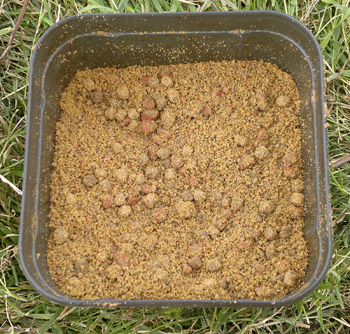 Over the years my feeder mix has changed. For many years I just soaked the pellets until soft and then pressed them lightly into a cage feeder. I then began to experiment with groundbait in order to get a cloud of small particles drifting downstream. Over the past year or so I’ve increased the ratio of groundbait to pellet to around 3 to 1 and used a much drier mix. Here’s how I do it.
Over the years my feeder mix has changed. For many years I just soaked the pellets until soft and then pressed them lightly into a cage feeder. I then began to experiment with groundbait in order to get a cloud of small particles drifting downstream. Over the past year or so I’ve increased the ratio of groundbait to pellet to around 3 to 1 and used a much drier mix. Here’s how I do it.
I place a good handful of 4mm and 6mm pellets in a large bait box, cover them with water and leave for about five minutes. I then add some dark method mix until I get a dry consistency that will just hold together when squeezed. I generally use a mix of Sonubaits Halli Crush and Sweet F1 (this last mix has a nice coarse particle size which I like). If bream are present then I suggest you dump the F1 mix unless you like catching them. You can play around with various method mixes, but I prefer a pure fishmeal mix with perhaps a hint of sweetness.
The above mix is then squeezed tightly into a cage feeder. In small and medium rivers I use Drennan Gripmesh feeders in medium and large sizes; on the Trent I use either the Matrix cage feeders or one of Paul Fisk’s Fantastic Feeders if feel I need to get a fair bit of bait in. The key thing to note is that when using the Drennan feeders I’m only putting between five and ten pellets in every cast. In tough conditions I will use small feeders with a dead cow lead attached so that I’m only feeding tiny quantities of pellet every cast.
Hook Baits
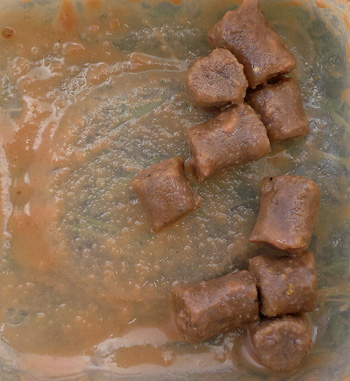 Until this year, unless I’ve been using maggots, I’ve used either 8mm halibut pellets or 10mm boilies as my hook baits. During the close season I began to wonder if there might be a better alternative to these baits and I decided to try something a little different.
Until this year, unless I’ve been using maggots, I’ve used either 8mm halibut pellets or 10mm boilies as my hook baits. During the close season I began to wonder if there might be a better alternative to these baits and I decided to try something a little different.
I’d got some Marukyu krill liquid (SFA 410) which I’d been using on my dead maggots, which I thought might make a good boilie flavouring. I did a bit of research, bought a shrimp meal based boilie mix and set to work in the kitchen. I couldn’t find any information on dosage levels for the krill liquid so I played safe and started with 5ml in a six egg mix. I’d decided against producing little round balls so I rolled the mix into long sausages and chopped them into individual baits. A one minute boil and a 24 hour air dry and the first batch of bait was popped into the freezer.
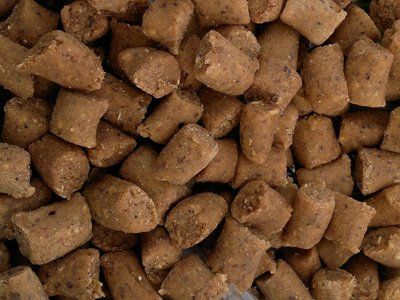 Once they were frozen I took out a small quantity, placed them in a freezer bag with a good glug of the krill liquid, gave them a good shake and placed them back into the freezer. As these baits thaw they will absorb some of the liquid into their surface layers, making them just a bit smellier than my free offerings.
Once they were frozen I took out a small quantity, placed them in a freezer bag with a good glug of the krill liquid, gave them a good shake and placed them back into the freezer. As these baits thaw they will absorb some of the liquid into their surface layers, making them just a bit smellier than my free offerings.
My thinking behind this is that firstly these baits smell slightly (but hopefully not too much) different from pellets and secondly they are not obviously boilies (i.e. not little round balls). The idea being that they give out similar food signals to the more usual baits, but are different enough so that barbel don’t view them as potentially dangerous. I’m now on my third batch of this bait and I’ve upped the quantity of krill liquid to one teaspoonful for every two eggs. This gives a slightly darker bait (the shrimp meal mix is very pale) without overdoing the flavour.
Au Naturel
Baits such as maggots and casters are used a lot for barbel especially when the rivers are low and clear. They have the disadvantage, however, of being attractive to small fish which can make life a little difficult at times. In my experience worms are also loved by barbel and lobworms or large Dendrobaenas are much less susceptible to attack by small fish. I’m now taking worms with me on every trip and making a point of using them.
Testing Times
It’s all very well trying a new bait, catching a few fish on it and declaring it a success, but how do you know it’s better than the bait you were using before? In the short term you can only fish the new against the old and compare results; in the long term your records (you do keep them don’t you?) will show you which is best. I have a slight problem in that most of the rivers I fish aren’t really suitable for a two rod approach. This means that I have to split a bait trial into two parts: the first is to fish the new bait exclusively to convince myself that it really works, the second is to fish a venue where I can fish two rods in the same swim and fish the new bait against the old.
Convincing myself that the new bait worked was the hard bit! The cold spring followed by sustained high pressure made the first month of the season hard. Pressure of work and family commitments meant that I was only able to get out once a week and these trips always seemed to coincide with the worst possible weather. Still, I persevered and by the end of July I was certain that my new hook baits were working. In better conditions I’d had multiple catches of barbel and a check on other anglers fishing the same stretches showed that I was consistently catching at least as many barbel on the harder days.
Phase two came with a rare free weekend and a pass out from she who must be obeyed. I persuaded Mick that two days on the tidal Trent would be a good idea so I could now test my new bait against his baits as well as my own. I set up two identical rigs and over the two days I fished them both on the same line, one with a 10mm boilie and one with one of my sweeties (well they do look like sweeties!). I switched the rods around during the day and switched the baits on each rod so that I was sure that other factors weren’t influencing my results.
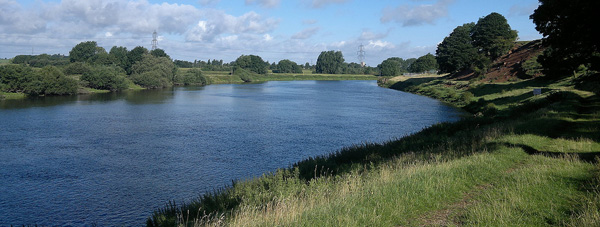
We picked a tough weekend and we had to work hard for our fish, fishing two different sections of river ten miles apart, the second of which involved a long walk. The results were interesting with five barbel to me against one to Mick (a highly experienced Trent angler) with all my barbel coming to the sweeties, although I did catch several bream and chub on the conventional boilies.
Conclusions
It’s early days still, but the new bait is certainly showing some promise. I suppose the question that springs to mind is whether it is the mix and flavour or the shape that is giving the results. My own gut feeling is that it’s the shape that makes the difference and I’ve got plans to try some Source mix I’ve got in the freezer against the new bait by making some sweeties from this and fishing them alongside the new bait.
I’m further along with the feeder mix and I’m now convinced that high groundbait to pellet ratios give much more consistent results. It’s interesting that I used this mix in my feeder on the Trent and that I still caught consistently despite (or maybe because of?) the small quantity of bait that I introduced over the weekend. It’s also worth noting that all my bites over the weekend came within a few minutes of recasting. With this mix you can afford to cast more often without over-feeding.
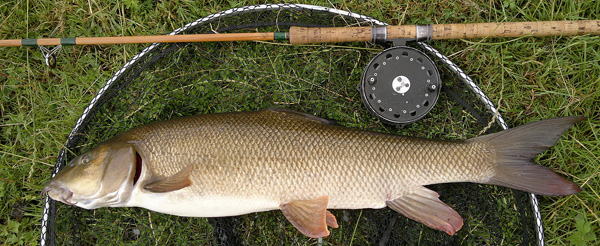
Now I’m not pretending that any of the above is revolutionary or that I’m the only angler trying things like this. I can think of two articles in the Angling Times recently that show that others are thinking along the same lines. Tommy Pickering wrote some months ago about his 50/50 feeder mix which is very similar to mine and Paul Garner wrote about using irregularly shaped krill boilies to great effect on the River Dove.
The thing about fishing is that you’re not likely to stumble across some revolutionary new bait that is going to make a massive difference to your results. The route to success is a logical series of small changes applied consistently over time. I hope I’ve convinced a few of you to be a bit more adventurous in your bait choices. If I have that’s brilliant because we’ll be in a small minority, as most people just won’t bother.










